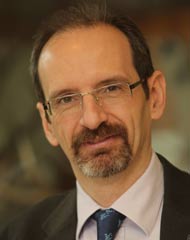Arturo Ariño Plana, Director Scientist of the Science Museum University of Navarra
World Darwin Day: the genius and the Education
In February, on the 12th, scientists around the world who study living things celebrate the birthday of one of the most famous researchers in history.

History tells us that Charles Darwin was born in February 1809. Although 210 years have passed, and 160 years have passed since the publication of "The Origin of Species", which he himself called "summary" (more than 400 pages long!) of his fundamental idea shared with Alfred Wallace about what makes life so varied, his explanation of such a familiar fact as evolution still surprises us today. Or, in other words, why species descend from common ancestors. A fact that is close, even evident, but that only came to light thanks to Darwin's genius.
Darwin's genius may have come from the factory. He was the grandson of Josiah Wedgewood, who made his fortune manufacturing exquisite and very expensive porcelain for the nobility and cheap copies that sold like hot cakes, before becoming even richer by inventing the marketing techniques that were to dominate the future market.
His future was, therefore, more than settled. Moreover, Darwin married another granddaughter of the magnate (his own cousin, Emma Wedgewood). Our story may have ended here with a quiet, perhaps idle life, well embedded in the society of the time, and cultivating his fortune.
Fortune was that he cultivated, instead, his Education. Darwin went to the Edinburgh Medical School at School , where he discovered his aversion to the unanesthetized surgery of the time. He then landed at Cambridge: the same University where, two centuries later, it was scientifically proven that although geniuses can be born, they are mostly made. Specifically, through good programs of study (28%), work (70%), and a good mentor.
A good mentor is the one that Darwin had there in the figure of his professor of Botany John Henslow, with whom he often walked and who considered him his most advanced student . So much so that he recommended him to accompany Captain Robert Fitz Roy on his expedition aboard the Beagle, a brigantine that was to set sail in 1831 to map the South American coasts. Darwin, moreover, could afford to pay for that trip without depending on any fickle ministerial agency to cover his expenses, nor for the 100,000 euros (of our time) that he invested in the scientific equipment he wanted to take on the trip.
The voyage on the Beagle -which was to last two years and was extended to almost five- meant an enormous work from which Darwin obtained large quantities of samples (minerals, plants, animals, and many data and observations). With them he formed a collection that he carefully catalogued when he was not seasick (that is, when the ship was at anchor and he could go ashore) and which he also documented in great detail.
The details with which he elaborated a careful record of each specimen were rooted in his time at the then University Museum of Edinburgh (University Museum, in the current Talbot Rice Gallery). Among the collections of that Museum, Darwin developed to the maximum his ability to classify rocks (he went from collector to accomplished geologist) and organisms. In fact, he became a refined taxonomist capable of recognizing all subject plants and animals in those collections.
The collections of the University Museum were, therefore, fundamental in Darwin's Education and contributed to his genius. It is not risky to affirm that, without them and without the deep taxonomic knowledge that they provided him, Darwin's brilliant intuition -which represents a basic theory to understand Biology- would not have materialized. Nor, perhaps, would our knowledge of life have reached the same point where it is today.
Today, the scientific collections of natural science museums around the world continue to fulfill this core function. They form the repository of our knowledge about what living things are like and how they change. What, after all, biodiversity is all about. The collections of science museums are today just as indispensable for training taxonomists, an essential scientific specialization program for understanding-and understanding, conserving-life on Earth.
The Earth is still in need of new Darwins: brilliant people who may have already been born and who will have the good fortune to count, for their Education, on the natural science museums.
